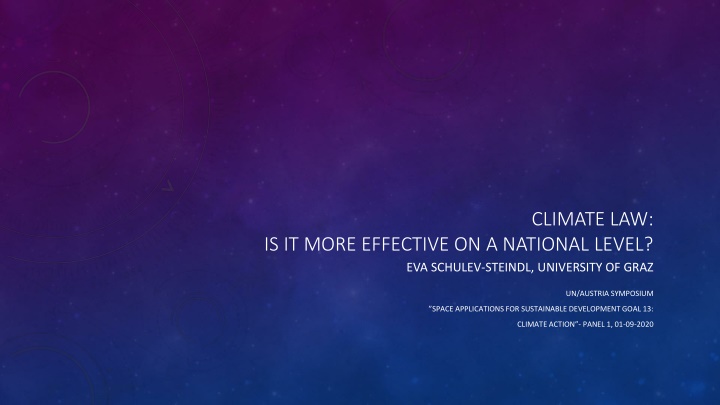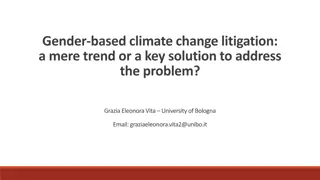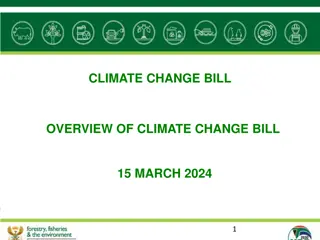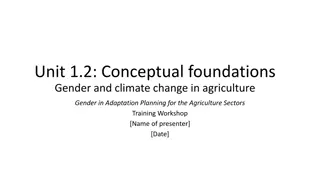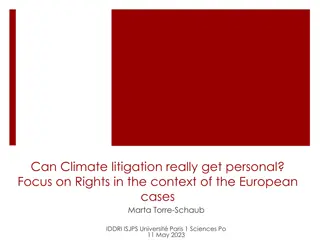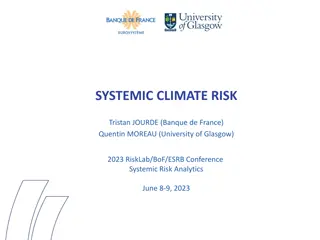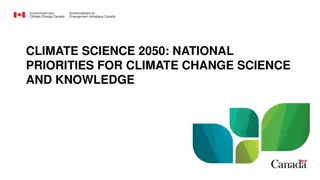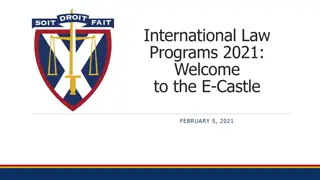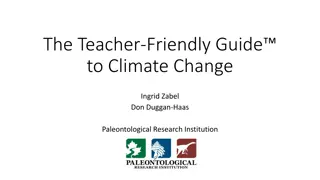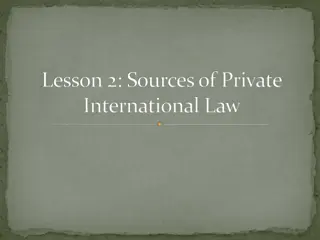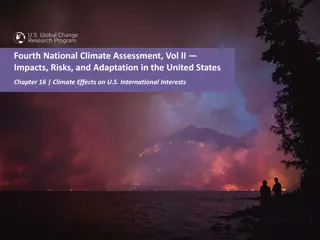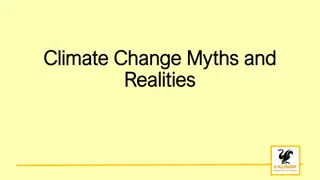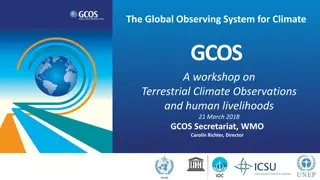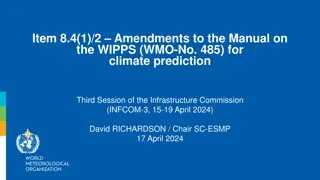Effectiveness of National vs. International Climate Law
The debate on the effectiveness of climate law at national vs. international levels is examined, focusing on key agreements like the Paris Agreement and EU climate strategies. The Paris Agreement sets ambitious global goals while requiring countries to submit their own action plans, while the EU implements specific legislation to reduce greenhouse gas emissions and promote renewable energies. By analyzing these frameworks, the discussion aims to understand the impact and efficiency of national and international climate laws in combating climate change.
Download Presentation

Please find below an Image/Link to download the presentation.
The content on the website is provided AS IS for your information and personal use only. It may not be sold, licensed, or shared on other websites without obtaining consent from the author.If you encounter any issues during the download, it is possible that the publisher has removed the file from their server.
You are allowed to download the files provided on this website for personal or commercial use, subject to the condition that they are used lawfully. All files are the property of their respective owners.
The content on the website is provided AS IS for your information and personal use only. It may not be sold, licensed, or shared on other websites without obtaining consent from the author.
E N D
Presentation Transcript
CLIMATE LAW: IS IT MORE EFFECTIVE ON A NATIONAL LEVEL? EVA SCHULEV-STEINDL, UNIVERSITY OF GRAZ UN/AUSTRIA SYMPOSIUM SPACE APPLICATIONSFOR SUSTAINABLE DEVELOPMENT GOAL 13: CLIMATE ACTION - PANEL 1, 01-09-2020
1. INTERNATIONAL CLIMATE LAW Paris Agreement (2015) Adopted by all UNFCCC Parties in December 2015 first universal, legally binding global climate agreement Follow up to Kyoto Protocol UNFCCC (1997) 2
PARIS AGREEMENT Emission Reduction long-term goal: increase in global average temperature well below 2 C above pre-industrial levels; aim to limit increase to 1.5 C (much lesser risks and impacts) global emissions to peak as soon as possible rapid reductions thereafter No binding reduction targets ( Kyoto Protocol for dev. countries) --> Countries to submit national climate action plans: (I)NDCs. every 5 years set more ambitious targets to be set report on implementation of targets 3
PARIS AGREEMENT EU s Nationally Determined Contribution (NDC): - 40% greenhouse gas emissions by 2030 compared to 1990 part of 2030 climate and energy framework Key legislation for implementing target: adopted by end of 2018 4
2. EU CLIMATE STRATEGIES Reduction of GHG emissions Increasing energy efficiency Increasing the share of renewable energies 2030 Climate & Energy Framework 2050 long-term strategy 2020 Climate & Energy Package A Clean Planet for all (COM/2018/773 final) 20% cut in greenhouse gas emissions 40% (from 1990 levels) 20% share of renewable energy consumption Green Deal: - 50% GHG emissions until 2030 32% 20% improvement in energy efficiency 32,5% 5
EU CLIMATE LAW Reducing GHG Emissions Emissions Trading System Emissions Trading Directive 2003/87 Central instrument of EU climate protection policy 43% reduction by 2030 (Directive 2018/410) Land Use, Land-Use Change and Forestry LULUCF Regulation 2018/841 Use of soils, trees, plants, biomass etc. CO from land use must be compensated: e.g. deforestation compensated by afforestation "no debit rule" Non ETS Sector Effort sharing Regulation 2018/842 30% reduction Individual targets for EU MS Austria: 36% reduction 6
EU CLIMATE LAW Increasing the share of renewable energies Increasing energy efficiency Renewable Energies Directive 2009/28 Governance Regulation 2018/1999 Integrated National Energy and Climate Plans (ev. 10 y.) -> assessed by EU-Comm. Long-Term Strategies for 30 years (ev. 10 y.) Energy Efficiency Directive 2012/27 7
Emission Certificates Act (ETS) Climate Protection Act (Non-ETS) Energy Efficiency Act Other Environmental Law Env. Impact Assessment Act Water Law Forest Law Air Pollution Control Law .. 3. AUSTRIAN CLIMATE LAW
AUSTRIAN CLIMATE PROTECTION ACT Defines emission ceilings for a total of six sectors for period 2008 - 2012 period 2013 - 2020 The act covers the following sectors: Energy and Industry (outside the EU-ETS) Transport Buildings Agriculture Waste Management Fluorinated Gases Target for 2030 still to be defined 9
Greenhouse gas emissions in Austria in 2016 AUSTRIA S EMISSIONS Austria's greenhouse gas emissions: trend for 1990 2017 and target Climate Protection Report 2019 In 2017, GHG emissions in Austria amounted to 82.3 million tonnes of CO2equivalent. Emissions were thus 3.3% (2.7 Mt) above the levels of 2016 and 4.6% above 1990 levels. In Austria, there have thus been no emission reductions since 1990, although a downward trend was recorded after 2005. Figure A: Trend of GHG emissions: trend and target path 2013 2020 Mt CO2 equivalent . Sources: UMWELTBUNDESAMT (2019a, b), EUESD https://www.umweltbundesamt.at/fileadmin/site/publik ationen/rep0702.pdf p 13 Climate policy targets for 2020 Effort Sharing Decision:
AUSTRIAN CLIMATE PROTECTION ACT - EVALUATION Structural weaknesses: Self-set goals not met: No substantial governance and responsability mechanism Compliance with international/EU obligations in Kyoto period 2008 - 2012 only due to extensive purchase of certificates Measures: no regular evaluation/sufficient involvement of scientific community Targets for 2013 - 2020 will only be met because of better performance in first years and due to Corona-crisis! Unambitious deadlines, no protection against delays, lack of external control mechanism
CONCLUSIONS EU-Law: provides suitable mechanisms in Climate Law though partly not effective enough (e.g. ETS: low carbon price, exemptions due to carbon leakage ) National law: does not go beyond EU law even were it could ( no gold plating ) not ambitious and effective enough Closing the g p? Climate lawsuits against states and enterprises, numerous cases worldwide (http://climatecasechart.com), also against EU and Austria
